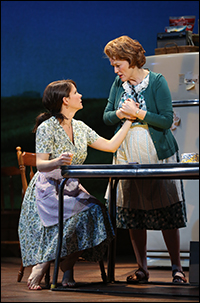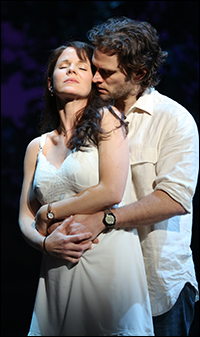
*
Fans of rhapsodically rich, soaringly theatrical musical scores like Carousel, The Most Happy Fella and The Light in the Piazza might profitably turn their attention to Jason Robert Brown's The Bridges of Madison County [Ghostlight]. Brown's newest musical doesn't — for several reasons — fall in the same category as the above-mentioned titles. The score itself, though, is a pyramid of strong, intelligent and melodic treasures that people who love this sort of thing will be happy to bask in, and it's been a while since we've been able to say that.
Bridges is based on the 1992 sentimental novel by Robert James Waller, which in turn was adapted into a 1995 big-screen blockbuster starring Meryl Streep and Clint Eastwood. It tells of Francesca (Kelli O'Hara), a displaced Neapolitan war bride. After 18 years on a farm in middle-of-nowhere Iowa — confined by her hard-working ex-GI husband, two squabbling teenagers, and no passion — she is swept off her feet by Robert (Steven Pasquale), a wandering photographer who is on assignment shooting the scenic bridges in the area. They meet, they are instantly smitten, they have a passionately torrid affair, they learn the secrets of life (as you might say). Ultimately, she refuses to desert her family and run away with him.
The musical, thus, is not much interested in action; it is a character study of the two protagonists. Brown examines them as if under a microscope, drawing them in music and lyrics with layer upon layer of insight. The nature of the show affords the composer the time, and the room, to create these characters from within: The things they say, the things they don't or can't say, the things they believe or think they believe. Brown digs deeper and deeper, over 14 powerful songs, and succeeds in grand and glorious manner.
The composer starts things off with a plaintive cello solo — Brown wrote the orchestrations, too, and they are superb — and Francesca's solo "To Build a Home." This memory piece follows the young bride as she sails from Naples across the sea, and then from Pennsylvania Station on "a train that slices like a scythe through the fields of America." The couple roosts on three hundred acres in rural Winterset, where "blade of grass by blade of grass, and ear of corn by ear of corn" she builds herself a home and a semblance of a life.
| |
 |
|
| O'Hara and Cass Morgan | ||
| photo by Joan Marcus |
"What Do You Call a Man Like That?" explores the initial attraction felt by this unavailable woman, while he counters with a song of "Wondering." This is one of the half-dozen beauties in the score. "You're wondering," he sings to himself no less than twelve times, like a cry in the night, concluding that "nothing's gonna happen." But of course it will. The song itself has one of those plaintive melodies that stays with you.
"Look at Me," a duet which crystallizes the burgeoning mutual attraction with cascading guitars, explodes with barely controllable excitement. "Don't offer your hand, don't reach for my waist, don't lean towards my lips, please — just look at me." The first act ends — and the affair is set afire — with another stunning song in which Robert sings, "All my life I have been falling, I have been falling into you." The words are purposely simple, set to a strong melodic line — accompanied by an insistent rhythmic heartbeat pounded into the piano — that turns the thing into sheer beauty.
"Who We Are and Who We Want to Be" is an effective morning-after song, in which both middle-aged characters discover themselves in a new and unexpected place. This leads to the musical peak of the show. Francesca starts by acknowledging that the affair has brought her new life, defined by the time "Before and After You." Robert follows this by an extended interlude ("For the First Time in My Life"), a minute-long section which — thanks to the bravery of the composer and the talent of Pasquale — is sung a cappella, after which the pair consummate the scene with another beauty virtually throbbing with emotion, "One Second and a Million Miles."
| |
 |
|
| Kelli O'Hara and Steven Pasquale | ||
| Photo by Joan Marcus |
There are two other major numbers along the way. "Almost Real" is a flashback to Francesca's life in Italy, when she "dreamed of a flat in Sienna on the market square" but life and war intervened. This is an extended sequence, somewhat like the "Count Ludovic of Austria" sequence in Sondheim's Passion, and it is exquisite. Elsewhere, there is a song for Robert's ex-wife Marian (Whitney Bashor), a character arguably shoehorned into the show; she does nothing else, just comes on, sings the song, and leaves. "Another Life" is remarkably good, though; if the character doesn't have a place in the story, the song thematically fits and enhances the show. Brown's talent at word-image is very much in evidence here; the ex-wife sees herself as "a woman wearing four years of confusion like a scar."
Certain elements of The Bridges of Madison County are not quite so successful as the songs for the two leading characters, but that's a discussion for another time and place. Brown's work is a major achievement of uncommon quality and should not be overlooked. As I was preparing this column, I paid another visit to Bridges on a blustery late April eve. The show played considerably better than it had at the preview I attended, while the two stars remained remarkably good. The CD, as you can garner from this report, earns my high recommendation. To those of you who have the opportunity to get over to the Schoenfeld, let me add that the combined power of Brown's score and O'Hara & Pasquale's singing is something that people who love musical theatre ought not miss. [As this column was about to go on-line, it was announced that The Bridges of Madison County will close May 18 after 137 performances.]
Brown has another musical waiting in the wings, as it were: Honeymoon in Vegas, which was highly acclaimed in its tryout last October at the Paper Mill Playhouse in Millburn, NJ. Honeymoon has a grand, musical comedy score; who knew that Brown could write so funny? It seems an odds-on favorite, in Vegas-speak, that the show will come to Broadway as soon as a suitable theatre can be cleared and prove a major crowd-pleaser (and a lucrative winner for the composer). But The Bridges of Madison County is his own personal Carousel.
(Steven Suskin is author of "Show Tunes," "The Sound of Broadway Music: A Book of Orchestrators and Orchestrations," "Second Act Trouble," the "Opening Night on Broadway" books, and "The Book of Mormon: The Testament of a Broadway Musical." He also writes the Aisle View blog at The Huffington Post. He can be reached at [email protected].)









